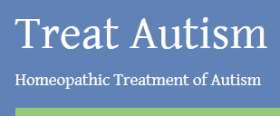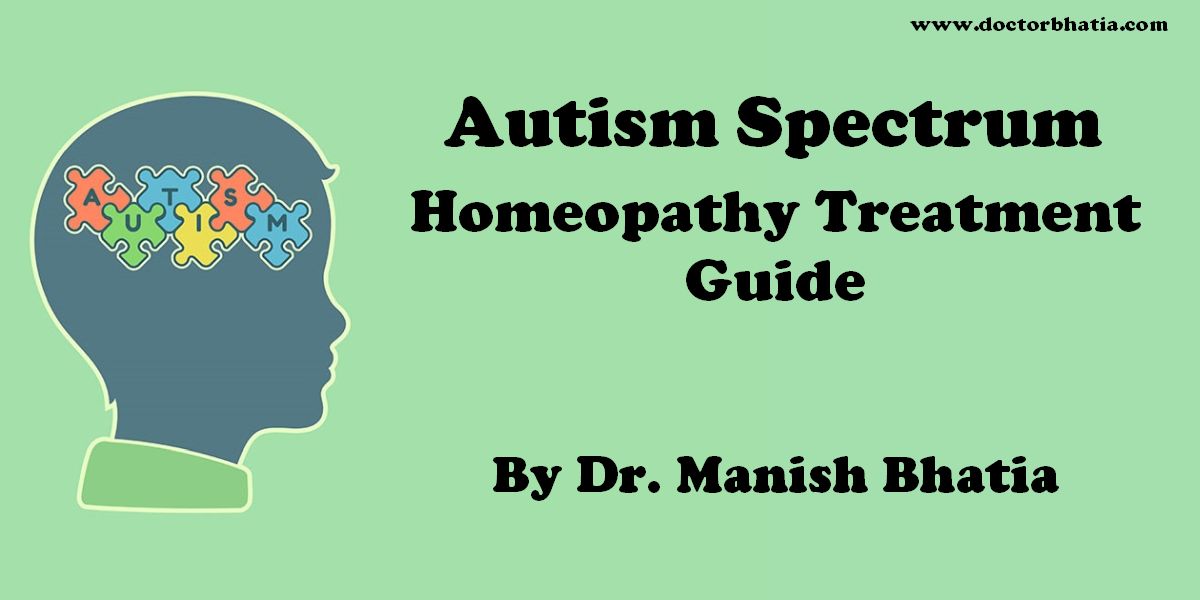
Click for Homeopathy Treatment of Autism in India
The autism spectrum, also called autism spectrum disorders (ASD) or autism spectrum conditions (ASC), with the word autistic sometimes replacing autism, is a spectrum of psychological conditions characterized by widespread abnormalities of social interactions and communication, as well as severely restricted interests and highly repetitive behavior.[1] A 2005 review estimated a prevalence of 6.0–6.5 per 1,000 for ASD. Of the various forms of ASD, pervasive developmental disorder not otherwise specified (PDD-NOS) was the vast majority, autism was at least 1.3 per 1,000, and Asperger syndrome was about 0.3 per 1,000; the atypical forms childhood disintegrative disorder and Rett syndrome were much rarer.[2]
Classification of Autism spectrum
The three main forms of ASD are autism, Asperger syndrome, and PDD-NOS. Autism forms the core of the autism spectrum disorders. Asperger syndrome is closest to autism in signs and likely causes;[3] unlike autism, Asperger’s has no significant delay in language development.[4] Pervasive developmental disorder not otherwise specified (PDD-NOS) is diagnosed when the criteria are not met for a more specific disorder. Some sources also include Rett syndrome and childhood disintegrative disorder, which share several signs with autism but may have unrelated causes; other sources combine ASD with these two conditions into the pervasive developmental disorders.[3][5]
The terminology of autism can be bewildering. Autism, Asperger’s and PDD-NOS are sometimes called the autistic disorders instead of ASD,[6] whereas autism itself is often called autistic disorder, childhood autism, or infantile autism.[7] Although the older term pervasive developmental disorder and the newer term autism spectrum disorder largely or entirely overlap,[5] the former was intended to describe a specific set of diagnostic labels, whereas the latter refers to a postulated spectrum disorder linking various conditions.[8] ASD, in turn, is a subset of the broader autism phenotype (BAP), which describes individuals who may not have ASD but do have autistic-like traits, such as avoiding eye contact.[7]
Characteristics
The defining characteristics of autism spectrum disorders are qualitative impairments of social communication and interaction, along with restricted and repetitive activities and interests.[9] Individual symptoms occur in the general population and appear not to associate highly, without a sharp line separating pathological severity from common traits.[10] Other aspects of ASD, such as atypical eating, are also common but are not essential for diagnosis; they can affect the individual or the family.[11]
An estimated 0.5% to 10% of individuals with ASD show unusual abilities, ranging from splinter skills such as the memorization of trivia to the extraordinarily rare talents of prodigious autistic savants.[12]
Contrary to common belief, autistic children do not prefer to be alone. Making and maintaining friendships often proves to be difficult for those with autism. For them, the quality of friendships, not the number of friends, predicts how lonely they are.[13] Being on the autism spectrum does not keep children from understanding race and gender stereotypes in a society; like neurotypical children they learn stereotypes by observing their parents’ actions, such as locking car doors when in certain neighborhoods.[14]
Management of Autism spectrum
The main goals of treatment are to lessen associated deficits and family distress, and to increase quality of life and functional independence. No single treatment is best and treatment is typically tailored to the child’s needs. Intensive, sustained special education programs and behavior therapy early in life can help children acquire self-care, social, and job skills. Available approaches include applied behavior analysis (ABA), developmental models, structured teaching, speech and language therapy, social skills therapy, and occupational therapy.[15]
Epidemiology
Most recent reviews tend to estimate a prevalence of 1–2 per 1,000 for autism and close to 6 per 1,000 for ASD;[16] because of inadequate data, these numbers may underestimate ASD’s true prevalence.[17] PDD-NOS is the vast majority of ASD, Asperger’s is about 0.3 per 1,000 and the remaining ASD forms are much rarer.[2] The number of reported cases of autism increased dramatically in the 1990s and early 2000s. This increase is largely attributable to changes in diagnostic practices, referral patterns, availability of services, age at diagnosis, and public awareness,[18] though as-yet-unidentified contributing environmental risk factors cannot be ruled out.[19]
Homeopathy Treatment for Autism spectrum
Keywords: homeopathy, homeopathic, treatment, cure, remedy, remedies, medicine
Homeopathy treats the person as a whole. It means that homeopathic treatment of Autism focuses on the patient as a person, as well as his pathological condition. The homeopathic medicines are selected after a full individualizing examination and case-analysis, which includes the medical history of the patient, physical and mental constitution, family history, presenting symptoms, underlying pathology, possible causative factors etc. A miasmatic tendency (predisposition/susceptibility) is also often taken into account for the treatment of chronic conditions. A homeopathy doctor tries to treat more than just the presenting symptoms. The focus is usually on what caused the disease condition? Why ‘this patient’ is sick ‘this way’. The disease diagnosis is important but in homeopathy, the cause of disease is not just probed to the level of bacteria and viruses. Other factors like mental, emotional and physical stress that could predispose a person to illness are also looked for. No a days, even modern medicine also considers a large number of diseases as psychosomatic. The correct homeopathy remedy tries to correct this disease predisposition. The focus is not on curing the disease but to cure the person who is sick, to restore the health. If a disease pathology is not very advanced, homeopathy remedies do give a hope for cure but even in incurable cases, the quality of life can be greatly improved with homeopathic medicines.
The homeopathic remedies (medicines) given below indicate the therapeutic affinity but this is not a complete and definite guide to the homeopathy treatment of this condition. The symptoms listed against each homeopathic remedy may not be directly related to this disease because in homeopathy general symptoms and constitutional indications are also taken into account for selecting a remedy. To study any of the following remedies in more detail, please visit the Materia Medica section at Hpathy.
None of these medicines should be taken without professional advice and guidance.
Homeopathy Remedies for Autism spectrum :
Carc., cann-i., nat-m., op., thuj.
References
- ^ World Health Organization (2006). “F84. Pervasive developmental disorders“, International Statistical Classification of Diseases and Related Health Problems, 10th ed. (ICD-10). Retrieved on 2007-06-25.
- ^ a b Fombonne E (2005). “Epidemiology of autistic disorder and other pervasive developmental disorders”. J Clin Psychiatry 66 (Suppl 10): 3–8. PMID 16401144.
- ^ a b Lord C, Cook EH, Leventhal BL, Amaral DG (2000). “Autism spectrum disorders”. Neuron 28 (2): 355–63. doi:. PMID 11144346.
- ^ American Psychiatric Association (2000). “Diagnostic criteria for 299.80 Asperger’s Disorder (AD)“, Diagnostic and Statistical Manual of Mental Disorders, 4th ed., text revision (DSM-IV-TR). ISBN 0890420254.
- ^ a b Strock M (2008). “Autism spectrum disorders (pervasive developmental disorders)“. National Institute of Mental Health. Retrieved on 2008-08-25.
- ^ Freitag CM (2007). “The genetics of autistic disorders and its clinical relevance: a review of the literature”. Mol Psychiatry 12 (1): 2–22. doi:. PMID 17033636.
- ^ a b Piven J, Palmer P, Jacobi D, Childress D, Arndt S (1997). “Broader autism phenotype: evidence from a family history study of multiple-incidence autism families” (PDF). Am J Psychiatry 154 (2): 185–90. PMID 9016266, https://ajp.psychiatryonline.org/cgi/reprint/154/2/185.pdf.
- ^ Klin A (2006). “Autism and Asperger syndrome: an overview“. Rev Bras Psiquiatr 28 (suppl 1): S3–S11. doi:. PMID 16791390, https://www.scielo.br/scielo.php?script=sci_arttext&pid=S1516-44462006000500002&lng=en&nrm=iso&tlng=en.
- ^ Frith U, Happé F (2005). “Autism spectrum disorder”. Curr Biol 15 (19): R786–90. doi:. PMID 16213805.
- ^ London E (2007). “The role of the neurobiologist in redefining the diagnosis of autism”. Brain Pathol 17 (4): 408–11. doi:. PMID 17919126.
- ^ Filipek PA, Accardo PJ, Baranek GT et al. (1999). “The screening and diagnosis of autistic spectrum disorders”. J Autism Dev Disord 29 (6): 439–84. doi:. “Erratum”. J Autism Dev Disord 30 (1): 81. 2000. doi:. PMID 10638459.
- ^ Treffert DA (2006). “Savant syndrome: an extraordinary condition—a synopsis: past, present, future“. Wisconsin Medical Society. Retrieved on 2008-03-24.
- ^ Burgess AF, Gutstein SE (2007). “Quality of life for people with autism: raising the standard for evaluating successful outcomes”. Child Adolesc Ment Health 12 (2): 80–6. doi:.
- ^ Hirschfeld L, Bartmess E, White S, Frith U (2007). “Can autistic children predict behavior by social stereotypes?”. Curr Biol 17 (12): R451–2. doi:. PMID 17580071. Lay summary (2007-06-19).
- ^ Myers SM, Johnson CP, Council on Children with Disabilities (2007). “Management of children with autism spectrum disorders“. Pediatrics 120 (5): 1162–82. doi:. PMID 17967921, https://pediatrics.aappublications.org/cgi/content/full/120/5/1162. Lay summary (2007-10-29).
- ^ Newschaffer CJ, Croen LA, Daniels J et al. (2007). “The epidemiology of autism spectrum disorders”. Annu Rev Public Health 28: 235–58. doi:. PMID 17367287.
- ^ Caronna EB, Milunsky JM, Tager-Flusberg H (2008). “Autism spectrum disorders: clinical and research frontiers”. Arch Dis Child 93 (6): 518–23. doi:. PMID 18305076.
- ^ Changes in diagnostic practices:
- Fombonne E (2003). “The prevalence of autism”. JAMA 289 (1): 87–9. doi:. PMID 12503982.
- Wing L, Potter D (2002). “The epidemiology of autistic spectrum disorders: is the prevalence rising?”. Ment Retard Dev Disabil Res Rev 8 (3): 151–61. doi:. PMID 12216059.
- ^ Rutter M (2005). “Incidence of autism spectrum disorders: changes over time and their meaning”. Acta Paediatr 94 (1): 2–15. doi:. PMID 15858952.

